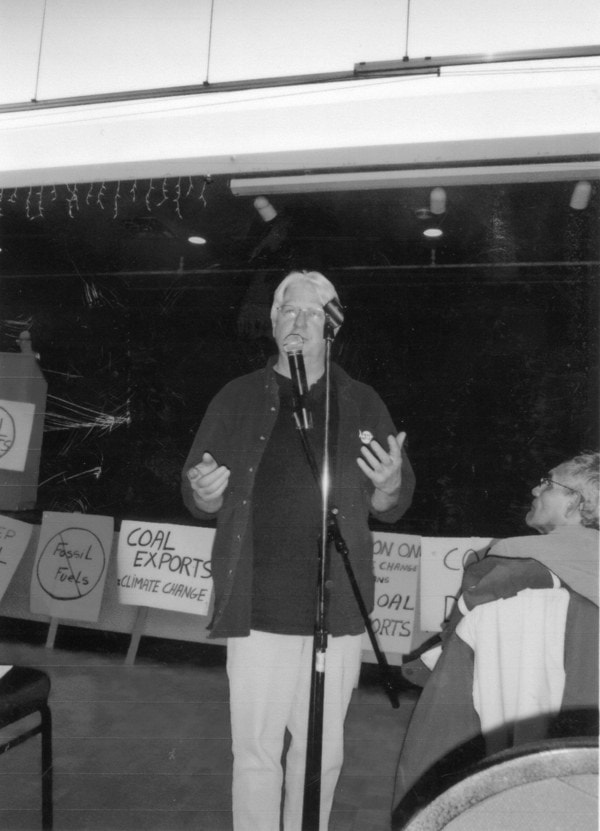On April 7 I attended a town hall meeting sponsored by Comox Valley Waterwatch with a view to getting some up-to-date information on the proposed Raven Coal Mine, inland from Fanny Bay on the headwaters of Cowie Creek. The lead speaker
was Arthur Caldicott, an energy analyst from Victoria who presented an excellent illustrated talk on energy as it related to the Baynes Sound problem. His presentation is the major source of information for this column.
Forgive us if we are a little paranoid when it comes to mine developments in the Comox Valley. A few years ago the mine on Mount Washington went broke and the mining company walked away. We were left with a mine site that leached poison into the Tsolum River and killed salmon and steelhead runs. Since then we have spent millions of dollars and thousands of hours of volunteer time trying to bring back this once productive salmon stream. The Tsolum is still a very sick river.
The proposed mine is the Raven underground coal mine, approximately 3,100 hectares located about five kilometres from Baynes Sound in Cowie Creek and Tsable River drainages. The current plan is to annually produce somewhere in the neighbourhood of 650,000 to 1.1 million tonnes of highly volatile bituminous coal to be shipped to Asian markets via Port Alberni.
The life of the mine is estimated to be 17 years plus or minus and it will create about 350 jobs. The primary use of the coal is in the manufacturing of steel. The surface footprint of the mine would be about 200 hectares.
Compliance Energy Corporation which is the parent company also has two other coal deposits of interest in our area – Bear Coal near Cumberland and in the Anderson Lake area just off the road leading to Mount Washington.
In the meantime, Baynes Sound is a major producer of shellfish that supports in the neighbourhood of 600 jobs in perpetuity as long as we maintain the clean integrity of the waters of Baynes Sound.
One of my passions is the simple act of being able to go on the foreshore of Baynes Sound to gather shellfish during appropriate tides. Knowing they are safe to eat, I have written many columns about this simple outdoor experience which gives much pleasure to local folks, retirees, families and tourists who visit our pristine waters.
There are not many places left in coastal waters where you can still gather seafood – let's not do anything that increases the risk to this precious resource in Baynes Sound. To put this important industry at risk from acid mine drainage seems totally irresponsible to my way of thinking.
We are currently in the final throes of a federal election, with a provincial one looming in the near future. It seems to me that politicians should be letting the voting public know there they stand on this mine proposal.
Connected to the mining of coal is another issue of the growing presence of carbon dioxide in our atmosphere and its effect on the growing menace of climate change. Coal is primarily stored carbon from millions of years ago that was sequestered from the atmosphere when the planet was much warmer than it is today. According to the best scientific minds of the day we are approaching a tipping point in the presence of atmospheric carbon dioxide that will trigger climate change, which will lead to the collapse of civilization as we know it. The burning of coal is a major producer of atmospheric carbon dioxide.
On a related matter I read in the April 11, 2011 issue of Time magazine an environmental special feature by Bryan Walsh. "This Rock Could Power the World - Why Shale Can Solve the Energy Crisis." "The Cleaner Fuel -Good Luck With That. Make No Mistake: in a post Fukushima world, the US will use this gas."
"Its important to cast the environmental controversies surrounding shale drilling against the backdrop of fossil fuel that, if all goes well, gas should help displace: coal. From mountaintop removal mining to its impact on climate change, cheap coal is toxic to the human race."
On a closing note, the meeting was well attended and I found it particularly inspiring that one of the speakers was a young woman in her early 20s who gave the graying audience her views of what she wanted her future to look like. I also enjoyed the fresh oysters.
.
